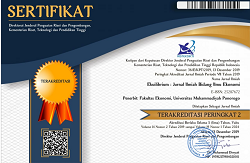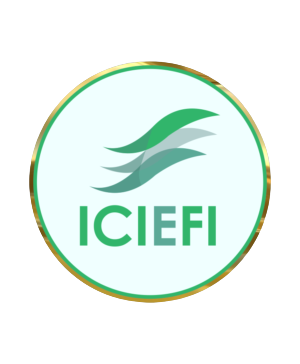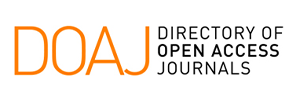Designing MSMEs Strategies to Survive in the New Normal Era with a SWOT-TOPSIS Approach
DOI: 10.24269/ekuilibrium.v17i1.2022.pp64-76
Abstract
The COVID-19 pandemic has had a significant impact on various sectors such as the healthcare system, tourism, trade, industry and economy sector especially on the economic activities of MSMEs. MSMEs are very vulnerable to being affected by business disruptions, because they are indirectly related to sectors affected by the pandemic such as the tourism sector, transportation to the culinary industry.However, in this COVID-19 pandemic, MSMEs lack of resilience and flexibility due to several things, such as the low level of digitalization, difficulties in accessing technology and a lack of understanding strategies to survive in business.So to overcome this challenge, MSMEs need to make accurate plans and strategies, so that companies can find out their strengths and weaknesses as well as opportunities and threats.SWOT analysis is used to obtain information derived from the analysis of the company's internal and external environmental situations.This analysis is needed to help develop MSMEs in recognizing their strengths and weaknesses as well as taking advantage of every existing opportunity and avoiding or minimizing threats in market competition.This research uses SWOT and TOPSIS analysis methods. SWOT analysis begins by weighting and ranking internal factors and external factors of MSMEs. The TOPSIS method is used to sort priorities from alternatives to the selected strategy.The results show that alternative strategies that can be applied are to create innovative new products, expand sales areas, increase promotions, turn business processes digital by using existing online platforms and expanding sales areas.
Keywords
References
- Afdhol, Rinaldi, Nia Rahmadani, Petir Papilo, and Muhammad Rizki. 2021. “Analisa Pengambilan Keputusan Pemilihan Bahan Dalam Pembuatan Kemeja Menggunakan Metode TOPSIS.” Jurnal Sains, Teknologi Dan Industri 18(2):163–72.
- Ahmad, Gilang Rusadi, and Ari Susantiaji. 2020. “Analisa Sebaran Klasifikasi Usaha Kecil Menengah (UKM) Di Kabupaten Tegal.” Geomedia: Majalah Ilmiah Dan Informasi Kegeografian 18(1):43–49. doi: 10.21831/gm.v18i1.31419.
- Aulawi, Hilmi, Rihsyan Adam Riansyah, and Rina Kurniawati. 2020. “ANALYSIS of the SELECTION of SHOE RAW MATERIAL SUPPLIERS by FUZZY TOPSIS METHOD.” Journal of Engineering Science and Technology 15(6):3983–90.
- Akmal, Muhammad, Tri Wahyudi, and Ratih Rahmahwati. 2021. “ANSANIA SAUDIA RAWIS HELWA HIJAB PONTIANAK DENGAN MENGGUNAKAN METODE SWOT DAN TOPSIS Muhammad Akmal , Tri Wahyudi , Ratih Rahmahwati.” Jurnal TIN Universitas Tanjungpura 5(1):162–69.
- Badan Pusat Statistik Kota Palembang. n.d. Produk Domestik Regional Bruto Kota Palembang Menurut Pengeluaran. Palembang.
- Dwi, Aviza, and Fadilla Citra. 2021. “Analysis of MSMEs Recovery Using Digital Technology in the Covid-19 Pandemic Era.” Ekuilibrium: Jurnal Ilmiah Bidang Ilmu Ekonomi 16(2):117–28.
- Ekonomi, Fakultas, Universitas Sriwijaya, and Jalan Palembang-indralaya. 1829. “PENGEMBANGAN EKONOMI LOKAL KOTA PALEMBANG MELALUI KAJIAN POTENSI KLASTER INDUSTRI KECIL : Pendekatan Tipology Klassen MUKHLIS ; DIRTA PRATAMA ATIYATNA ; NABILA DEHANNISA PENDAHULUAN Pertumbuhan Ekonomi Adalah Indikator Ekonomi Yang Bisa Memperlihatkan Gam.” 67–80.
- Hardilawati, Wan laura. 2020. “Strategi Bertahan UMKM Di Tengah Pandemi Covid-19.” Jurnal Akuntansi Dan Ekonomika 10(1):89–98. doi: 10.37859/jae.v10i1.1934.
- Hutasoit, Rahel Adelina, Solikhun Solikhun, and Anjar Wanto. 2018. “Analisa Pemilihan Barista Dengan Menggunakan Metode Topsis (Studi Kasus: Mo Coffee).” KOMIK (Konferensi Nasional Teknologi Informasi Dan Komputer) 2(1):256–62. doi: 10.30865/komik.v2i1.935.
- Inayati, Titik, Evianah, and Hendra Prasetya. 2018. “Perumusan Strategi Dengan Analisis SWOT Pada Usaha Mikro Kecil Menengah (Studi Kasus UMKM Produk Sepatu Di Mojokerto, Jawa Timur).” Seminar Nasional Manajemen Dan Bisnis Ke-3 217–31.
- Istiqomah, Istiqomah, and Irsad Andriyanto. 2018. “Analisis SWOT Dalam Pengembangan Bisnis (Studi Pada Sentra Jenang Di Desa Kaliputu Kudus).” BISNIS : Jurnal Bisnis Dan Manajemen Islam 5(2):363–82. doi: 10.21043/bisnis.v5i2.3019.
- Khaeruddin, Gina Nurushohifa, Kholil Nawawi, Abrista Devi, Universitas Ibn, and Khaldun Bogor. 2020. “Faktor-Faktor Yang Mempengaruhi Pendapatan Umkm Di Masa Pandemi Covid-19 (Studi Kasus Pedagang Kaki Lima Di Desa Bantar Jaya Bogor).” Jurnal AKRAB JUARA 5(November):86–101.
- Kristina, Titin. 2018. “Sistem Pendukung Keputusan Dengan Menggunakan Metode TOPSIS Untuk Pemilihan Lokasi Pendirian Grosir Pulsa.” Paradigma 20(1):8–12.
- Lumbanraja, Prihatin, Ritha F. Dalimunthe, and Elisabet Siahaan. 2021. “Developing Business Strategies for Featured SMEs in North Sumatera: SWOT Analysis Approach.” Proceedings Ofthe 2nd Economics and Business International Conference (EBIC 2019) - Economics and Business in Industrial Revolution 4.0 284–90.
- Miles, M. B., and A. .. Huberman. 1992. Analisis Data Kualitatif: Buku Sumber Tentang Metode Metode Baru. Jakarta: UI Press.
- OECD. 2020. “Covid-19: SME Policy Responses.” Oecd 2020 (March):1–55.
- Rasyid, Reizano Amri, and Rachma Rizqina Mardhotillah. 2021. “RENCANA PEMBANGUNAN UNIT STONE CRUSHER BARU DI.” Media Mahardhika 19(2):328–41.
- Rosmita, Dini Setyorini. 2020. “Jurnal Mitra Manajemen ( JMM Online ).” Jurnal Mitra Manajemen 4(12):1599–1606.
- Soetjipto, Noer. 2020. Ketahanan UMKM Jawa Timur Melintasi Pandemi COVID-19.
- Subaktilah, Yani, Nita Kuswardani, Sih Yuwanti, and Magister. 2018. “Analisis SWOT: Faktor Internal Dan Eksternal Pada Pengembangan Usaha Gula Merah Tebu.” Jurnal Agroteknologi 12(02):107–15.
- Sugiri, Dani. 2020. “Menyelamatkan Usaha Mikro, Kecil Dan Menengah Dari Dampak Pandemi Covid-19.” Fokus Bisnis : Media Pengkajian Manajemen Dan Akuntansi 19(1):76–86. doi: 10.32639/fokusbisnis.v19i1.575.
- Susilawati, Susilawati, Reinpal Falefi, and Agus Purwoko. 2020. “Impact of COVID-19’s Pandemic on the Economy of Indonesia.” Budapest International Research and Critics Institute (BIRCI-Journal): Humanities and Social Sciences 3(2):1147–56. doi: 10.33258/birci.v3i2.954.
- Sustiyo Wandi, et. a. 2013. “Pembinaan Prestasi Ekstrakurikuler Olahraga Di Sma Karangturi Kota Semarang.” Active - Journal of Physical Education, Sport, Health and Recreation 2(8):524–35. doi: 10.15294/active.v2i8.1792.
- Winarto, Ashif Jauhar. 2021. “ANALISIS SWOT SEBAGAI STRATEGI DALAM MEMBANTU PEREKONOMIAN UMKM JASA KONVEKSI @ANFCREATIVE.ID DI ERA PANDEMI.” Syntax Literate: Jurnal Ilmiah Indonesia 6(1):74–88.
Refbacks
- There are currently no refbacks.

This work is licensed under a Creative Commons Attribution-ShareAlike 4.0 International License.













